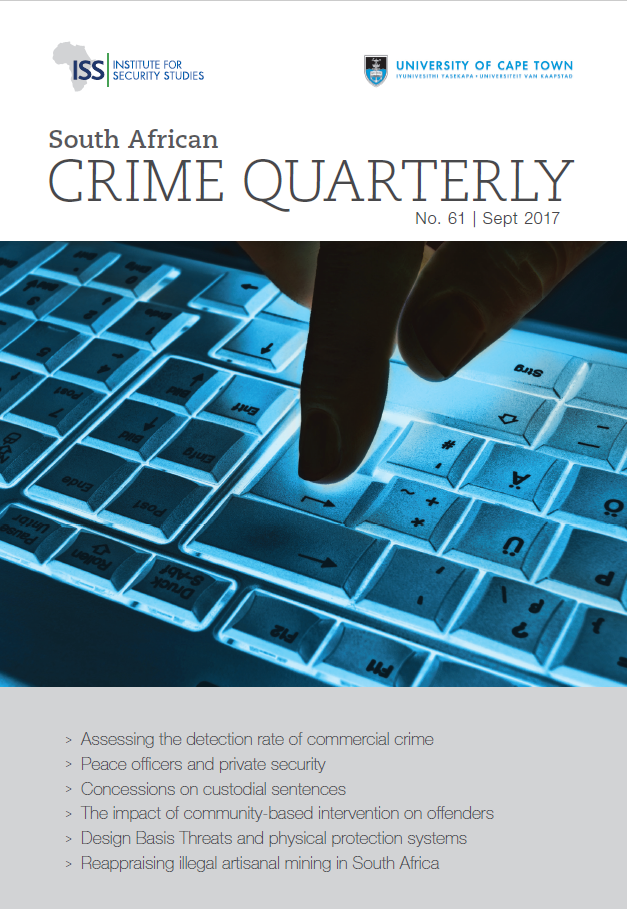Pathways from violence: The impact of community based intervention on offender reintegration in Gugulethu
DOI:
https://doi.org/10.17159/2413-3108/2017/i61a2605Keywords:
social integration, community-based intervention, prisoner re-entry, criminal justice reformAbstract
Section 36 of the Correctional Services Act describes the purpose of imprisonment as “enabling the sentenced prisoner to lead a socially responsible and crime-free life in the future.” But interviews with 48 young ex-prisoners in Gugulethu revealed a stark discrepancy between rhetoric and reality. Analysis outlined obstacles to integration, both psycho-social and material in nature, which community-level organizations were unable to fix on their own. To construct viable pathways to integration, and satisfy its legislative mandate, the Department of Correctional Services (DCS) must initiate large-scale coordination with civil society organisations.
Downloads
References
A Altbeker, A country at war with itself: South Africa’s crisis of crime, Jeppestown: Jonathan Ball Publishers, 2007.
C Woody, The 50 most violent cities in the world, http://www.businessinsider.com/most-violent-cities-in-the-world-2017-4/ (Accessed 6 June 2017).
Gallup, Global Law and Order 2015, http://www.gallup.com/services/185807/gallup-global-law-order-2015-report.aspx?utm_source=genericbutton&utm_medium=organic&utm_campaign=sharing (Accessed 6 June 2017).
P Herman, There's been a 3 000% increase in prisoners serving life sentences since 1995 – LHR, News24, 20 September 2016, http://www.news24.com/SouthAfrica/News/theres-been-a-3-000-increase-in-prisoners-serving-life-sentences-since-1995-lhr-20160920 (Accessed 6 June 2017).
L Muntingh, After prison: The case for offender reintegration, https://issafrica.s3.amazonaws.com/site/uploads/Mono52.pdf (Accessed 28 May 2017).
Sapa, Ndebele: SA has highest prison population in Africa, Mail & Guardian, 11 February 2013, https://mg.co.za/article/2013-02-11-south-africa-has-highest-prison-population-in-africa-says-ndebele (Accessed 28 May 2017).
Judicial Inspectorate for Correctional Services, Annual Report 2014/2015, http://judicialinsp.dcs.gov.za/Annualreports/JUDICIAL%20INSPECTORATE%20FOR%20CORRECTIONAL%20SERVICES%20ANNUAL%20REPORT%20FINAL2014-2015.pdf, (accessed 28 May 2017).
NICRO, The State of South African Prisons, http://press.nicro.org.za/images/PDF/Public-Education-Paper-The-State-of-South-African-Prisons-2014.pdf (accessed May 28 2017).
Department of Correctional Services, The White Paper on Corrections, www.dcs.gov.za/AboutUs/COE/Documents/WhitePaper/WHITE%20PAPER%208.doc, (accessed 12 April 2017).
Department of Correctional Services, Annual Performance Plan 2016/2017, http://www.dcs.gov.za/docs/2016 doc/Annual Performace Plan 2016-2017.pdf, (accessed 8 May 2017).
MA Cohen and AR Piquero, New evidence on the monetary value of saving a high risk youth, Journal of Quantitative Criminology 25 (2009), 25-49.
World Prison Brief, South Africa, http://www.prisonstudies.org/country/south-africa (Accessed May 28 2017).
MA Pillay, The making of people: The story of gangs on the Cape Flats, Word and Action 53 (425) (2014), 25-32.
M Plaatjie, Gugulethu: The fragments of unwritten history, Cape Town: Salty Print, 2013.
Census for Gugulethu, City Population, https://www.citypopulation.de/php/southafrica-cityofcapetown.php?cid=199030 (accessed 6 May 2017).
Crime Stats SA, Murder: Worst ten precincts in 2016, https://www.crimestatssa.com/topten.php (accessed 6 May 2017).
I Eigelaar-Meets, C Groenewald, P Cloete, W Louw, C Poole, F Kotze, A social and demographic trends analysis of the Western Cape: 2011/2012, http://soreaso.co.za/reports/Social%20and%20Demographic%20Trends%20Analysis_Western%20Cape_8%20March%202012.pdf, 39 (accessed 6 May 2017).
A Pluddemann, C Parry, A Bhana, S Dada, D Fourie, South African Community Epidemiology Network on Drug Use (SACENDU): update: alcohol and drug abuse trends: July - December 2009 (Phase 27), http://www.hsrc.ac.za/en/research-data/view/5191 (accessed 6 May 2017).
MS van Heerden, AT Grimsrud, S Seedat, L Myer, DR Williams, DJ Stein, Patterns of substance use in South Africa: Results from the South African Stress and Health Study, South African Medical Journal 99(5) (2009), 358-366.
R Chetty, Social complexity of drug abuse, gangsterism and crime in Cape Flats’ schools, South African Journal of Criminology 3 (2015), 54-65.
Department of Correctional Services, Annual Report 2015/16, http://www.dcs.gov.za/docs/2016%20doc/DCS%20Annual%20Report%202015-16.pdf (Accessed 28 May 2017).
V Braun and V Clarke, Using thematic analysis in psychology, Qualitative Research in Psychology, 3 (2) (2006), 77-101.
Statistics South Africa, National and provincial labour: Youth, http://www.statssa.gov.za/publications/P02114.2/P02114.22015.pdf, (accessed 2 May 2017).
L Muntingh and J Redpath, The socio-economic impact of pre-trial detention in Kenya, Mozambique and Zambia, Dullah Omar Institute, 2016.
DJ Rossouw and LS van Zyl, Fifth Interim Report: Taxi violence in the Western Cape and in general, Goldstone Report Booklet – Human Rights Institute of South Africa, http://hurisa.org.za/wp-content/uploads/2009/11/Goldstone-Booklet.pdf (accessed 9 May 2017).
K Peltzer, S Ramlagan, G Mohlala and G Matseke, Illicit drug use trends in South Africa, Human
Sciences Research Council, http://www.hsrc.ac.za/en/research-data/ktree- doc/1073 (accessed 2 May
.
P Mayaki, Social worker at Realistic, Personal correspondence, 20 February 2017.
S Madikane, Executive director of Realistic, Personal correspondence, 20 February 2017.
JC Blodgett, NC Maisel, IL Fuh, PL Wilbourne and JW Finney, How effective is continuing care for substance use disorders? A meta-analytic review, Journal of Substance Abuse Treatment 46 (2) (2014), 1-24.
R Fiorentine, After Drug Treatment: Are 12-Step Programs Effective in Maintaining Abstinence? American Journal of Drug and Alcohol Abuse 25(1) (1999), 93-116.
R Gonzales, A Ang, DA Murphy, DC Glik and MD Anglin, Substance Use Recovery Outcomes among a Cohort of Youth Participating in a Mobile-Based Texting Aftercare Pilot Program, Journal of Substance Abuse Treatment 47 (1) (2014), 20-26.
Expanded Public Works Programme, City of Cape Town, http://www.capetown.gov.za/Work and business/Jobs-and-skills-development/Work-for-the-City-of-Cape-Town/Find-an-opportunity-with-EPWP (accessed 3 May 2017).
Downloads
Published
Issue
Section
License
Copyright (c) 2017 Author and Institute for Security Studies

This work is licensed under a Creative Commons Attribution 4.0 International License.
SACQ is licenced under a creative commons licence (CC BY) that allows others to distribute, remix, tweak, and build upon your work, even commercially, as long a they give appropriate credit, provide a link to the license, and indicate if changes were made. They may do so in any reasonable manner, but not in any way that suggests the licensor endorses you or your use.
Copyright for articles published is vested equally between the author/s, the Institute for Security Studies and the Centre of Criminology (UCT).




.png)